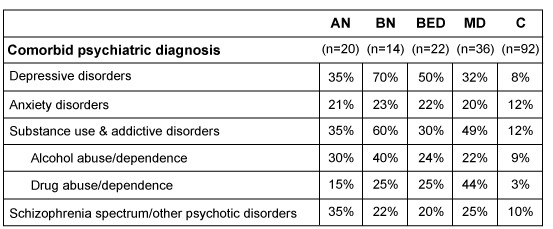Passage
A common misconception in medicine is that eating disorders present similarly in males and females. Research suggests that this is untrue: males meeting diagnostic criteria for eating disorders are more likely than females to have another psychiatric illness, demonstrate a later age of onset, and engage in excessive exercise. They are less likely to engage in purging behaviors, be diagnosed by clinicians, or seek treatment. When males do enter treatment, they are generally further along in the course of the illness.The classification of eating disorders in males according to the Diagnostic and Statistical Manual of Mental Disorders, Fifth Edition (DSM-5) has recently been debated. Research suggests that one very common manifestation of eating disorder etiology in males, called muscle dysmorphia (MD) , includes an obsession with a larger and more muscular body, which contrasts with the thin, idealized body for females with eating disorders. Characterized as a subset of body dysmorphic disorder, MD is more recently conceptualized as part of a spectrum of eating disorders; however, it is still classified under the obsessive-compulsive and related disorders umbrella in the DSM-5.One study applied the latest DSM-5 diagnostic criteria for anorexia nervosa (AN) , bulimia nervosa (BN) , binge eating disorder (BED) , and MD to the medical records of male veterans treated in Veterans Administration (VA) hospitals across the United States from 2000 to 2015. The study (Table 1) found a significant increase in psychiatric comorbidity compared to controls (C) .Table 1 Prevalence of Psychiatric Disorders for Eating Disorder and MD Cases and Controls in a National Sample of Male Veterans Treated at VA Hospitals from 2000 to 2015

-The DSM-5 describes AN as characterized by a distorted body image and excessive food restriction leading to severe weight loss. How would a behaviorist explain the behavior of an individual diagnosed with AN?
A) The eating behavior is evidence of a biochemical imbalance in the dopamine reward system in the brain.
B) Positive attention from others for initially losing weight motivates the individual to want to lose more weight.
C) The individual is behaving in a way to attain the "thin ideal" portrayed by celebrities in the media.
D) The individual most likely has a close friend or family member with an eating disorder and is imitating that behavior.
Correct Answer:
Verified
Q46: Passage
A common misconception in medicine is that
Q47: Passage
Before memories have been consolidated they are
Q48: Passage
Across the lifespan, mental and physical health
Q49: Passage
Before memories have been consolidated they are
Q50: Passage
Across the lifespan, mental and physical health
Q52: Passage
Across the lifespan, mental and physical health
Q53: Passage
The highly addictive nature of cigarettes can
Q54: Passage
The highly addictive nature of cigarettes can
Q55: Passage
The highly addictive nature of cigarettes can
Q56: Passage
Across the lifespan, mental and physical health
Unlock this Answer For Free Now!
View this answer and more for free by performing one of the following actions

Scan the QR code to install the App and get 2 free unlocks

Unlock quizzes for free by uploading documents